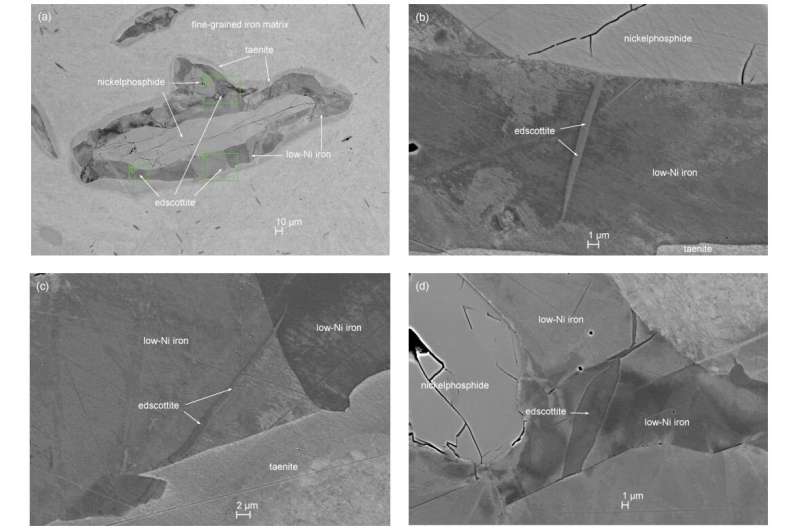September 11, 2019 report
Mineral never before found naturally on Earth discovered in meteorite

A team of researchers from the California Institute of Technology, the University of California and Maine Mineral & Gem Museum has found a mineral in a meteorite that does not form naturally on Earth. In their paper published in the journal American Mineralogist, the group describes their study of the mineral and suggest ways it might have come to exist.
Back in 1951, a black and red charred meteorite was found near the rural town of Wedderburn, in Australia. It eventually made its home in the Museums Victoria Collections, where it has remained. Over the years, workers at the museum sliced off tiny bits of the meteorite (which was named, appropriately enough, the Wedderburn meteorite) and sent them to researchers around the world looking to better understand its makeup and origin. Last year, the researchers with this new effort took another look at a sample that had been sent to CIT—this time, with an electron microscope and associated probe. In so doing, they discovered evidence of a mineral that does not occur naturally on Earth—the team promptly named it edscottite, after Edward R.D. Scott, who had identified a formula for the mineral back in the 1970s. The curator of the Museums Victoria, Stuart Mills, reported that finding a mineral made naturally that had first been created in a lab is very rare, noting that scientists have discovered over a half-million minerals in the lab, less than 6,000 of which have ever been found in nature.
Humans have been making the mineral for many years, incidentally—it is a byproduct of smelting. They have also been making it in science labs to learn more about its nature. Until now, it was called Fe5C2—traditionally, minerals are not given formal names unless they occur naturally.
It is not known how the mineral was formed, of course, but it appears likely that the meteorite it came from was once part of a much larger body—perhaps a planet or a moon. Some in the field have already suggested that the mineral was made in the core of a planet with a lot of heat. After that, it appears likely that the planet suffered a collision of some sort that broke it into fragments, one of which made its way to Australia.
More information: Chi Ma et al. Edscottite, Fe5C2, a new iron carbide mineral from the Ni-rich Wedderburn IAB iron meteorite, American Mineralogist (2019). DOI: 10.2138/am-2019-7102
© 2019 Science X Network





















